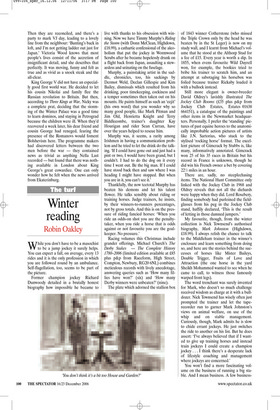Winter reading
Robin Oakley
While you don’t have to be a masochist to be a jump jockey it surely helps. You can expect a fall, on average, every 13 rides and it is the only profession in which you are followed round by an ambulance. Self-flagellation, too, seems to be part of the picture.
Former champion jockey Richard Dunwoody detailed in a brutally honest biography how impossible he became to live with thanks to his obsession with winning. Now we have Timmy Murphy’s Riding the Storm (with Donn McClean, Highdown, £18.99), a cathartic confessional of the alcoholism that put the jockey in Wormwood Scrubs after he became hopelessly drunk on a flight back from Japan, assaulting a stewardess and urinating on the fuselage.
Murphy, a painstaking artist in the saddle, chronicles, too, his sackings by Dermot Weld, Declan Gillespie and Kim Bailey, dismissals which resulted from his drinking, poor timekeeping, cockiness and a temper sometimes then taken out on his mounts. He paints himself as such an ‘eejit’ (his own word) that you wonder why so many good people, like Mark Pitman and Jim Old, Henrietta Knight and Terry Biddlecombe, trainer’s daughter Kay Hourigan and rider Sean Curran, have over the years helped to rescue him.
Murphy was, it seems, a rarity among Irishmen in having a communication problem and he tried to let the drink do the talking. ‘If I could have gone out and just had a pint or two, I would have been grand, but I couldn’t. I had to do the dog on it every time I went out. Be the big man. If I could have stood back then and saw where I was heading I might have stopped. But when you are in it, you can’t see it.’ Thankfully, the now teetotal Murphy has beaten his demons and let his talent flower. He talks sensibly about riding or training horses. Judge trainers, he insists, by their winners-to-runners percentages, not by gross totals. And this is on the pressure of riding fancied horses: ‘When you ride an odds-on shot you are the penaltytaker, when you ride a horse that is odds against or not favourite you are the goalkeeper. No pressure.’ Racing volumes this Christmas include grander offerings. Michael Church’s The Derby Stakes — The Complete History 1780–2006 (limited edition available at £85 plus p&p from Raceform, High Street, Compton, Newbury, RG20 6NL) combines meticulous records with lively anecdotage, answering queries such as ‘How many fillies have won?’ (six) and ‘How many Derby winners were unbeaten?’ (nine).
The plate which adorned the stallion box of 1843 winner Cotherstone (who missed the Triple Crown only by the head he was beaten by in the St Leger) is now on my study wall, and I learnt from Michael’s volume that he stood at the Althorp Stud for a fee of £15. Every year is worth a dip. In 1855, when evens favourite Wild Dayrell won, for example, the bookies tried to bribe his trainer to scratch him, and an attempt at sabotaging his horsebox was foiled because trainer Rickaby loaded it with a bullock instead.
Still more elegant is owner-breeder David Oldrey’s lavishly illustrated The Jockey Club Rooms (£35 plus p&p from Jockey Club Estates, Estates 01638 664151), a catalogue of the paintings and other items in the Newmarket headquarters. Personally, I prefer the ‘standing’ pictures of past equine heroes to the anatomically improbable action pictures of artists like J.N. Sartorius, who stuck to the stylised ‘rocking horse’ format. The excellent picture of Gimcrack by Stubbs is, like many, informatively annotated. Gimcrack won 25 of his 35 races in Britain but his record in France is unknown, though he did win his French owner a bet by covering 221/2 miles in an hour.
There are, sadly, no steeplechasing items. The National Hunt Committee only linked with the Jockey Club in 1968 and Oldrey reveals that not all the diehards were happy when they did. Lord Rosebery, finding somebody had purloined the fieldglasses from his peg in the Jockey Club stand, huffily declared, ‘This is the result of letting in those damned jumpers.’ My favourite, though, from the winter collection is Nick Townsend’s authorised biography, Mark Johnston (Highdown, £18.99). I always relish the chance to talk to the Middleham trainer in the winner’s enclosure and learn something from doing so, and here are the stories behind the successes of horses like Mister Baileys, Double Trigger, Fruits of Love and Attraction (the one horse in the yard Sheikh Mohammed wanted to see when he came to call, to witness those famously warped front legs).
The word trenchant was surely invented for Mark, who doesn’t so much challenge received wisdom as charge at it with a bulldozer. Nick Townsend has wisely often just prompted the trainer and let the taperecorder run to garner Mark Johnston’s views on animal welfare, on use of the whip and on stable management. Curiously, though, Mark admits he is slow to chide errant jockeys. He just switches the ride to another on his list. But he does assert: ‘I’ve always believed that if I wanted to give up training horses and instead train jockeys I could create a champion jockey ... I think there’s a desperate lack of lifestyle coaching and management where jockeys are concerned.’ You won’t find a more fascinating volume on the business of running a big stable. And I mean business. A few business men have become trainers, with varying success rates. The ‘always thinking’ Mark Johnston is one of the few trainers whom you would back to prosper making the switch the other way.







































































































































 Previous page
Previous page